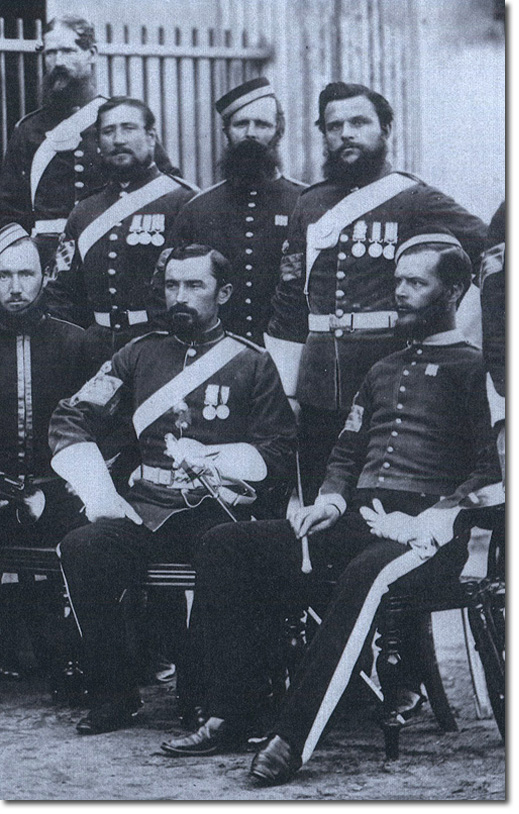|
|

 |
|
This detail from a group photo shows sergeants and Troop sergeant-majors of the Queen's Bays in India in 1865. Some are in stable dress and some in dress uniform. The white trouser stripe on the seated figure, and his white collar and cuffs are indicators to confirm the identity of the regiment. The dress tunic appears to have a dark collar, more visible on the less-whiskered TSM seated in the middle. This is because the white collar had a wide lace button loop. It was of yellow cloth for other ranks, but gold for Warrant Officers. Yellow would appear dark in photos of this vintage, and gold could also be dark in certain lights. The four chevrons with embroidered crown on the right arms of the two TSMs in this photo and the three crowned chevrons of the sergeants are all in gold lace on white cloth. Unfortunately the gauntlets cover the cuffs but they are simple round white cuffs embellished with a laced chevron and a central brass button. The shoulder straps are white edged with either yellow or gold depending on rank.
The white leather pouchbelts have a small white pouch attached to the front for the percussion caps. The TSMs do not have this as the Sharps carbines, used by the Queen's Bays in the Indian Mutiny, were only carried by sergeants and lower ranks. The white waistbelts differ in this photo. The two standing figures have the rectangular brass plate but the seated TSM has a snake clasp, as do others in the larger photo. The trousers at this time had leathered bottoms and inside leg, for mounted duty but unleathered for dismounted duty. The men in dress uniform have removed their helmets which are the 1847-71 models. One seated sergeant and a bearded sergeant standing in the middle are in stable dress which is a scarlet waist-length fitted jacket with white facings, blue pill-box cap with gold capband, and blue trousers with a broad white stripe. They have a medal ribbon for the Indian Mutiny campaign while the men in dress uniform have the medals. The medal for the mutiny has white and red stripes which can be seen on the two standing men. The other medals look as if they are for the Crimea, but the Bays were not there as a regiment. Some men may have served in the Crimea on detachment, or have come from another regiment in 1856, in time to take part in the Mutiny operations of 1858-9. |
Armed Forces | Art and Culture | Articles | Biographies | Colonies | Discussion | Glossary | Home | Library | Links | Map Room | Sources and Media | Science and Technology | Search | Student Zone | Timelines | TV & Film | Wargames Library | Search | TV & Film | Wargames
